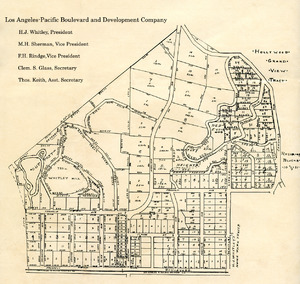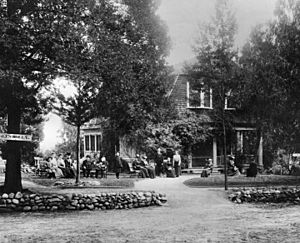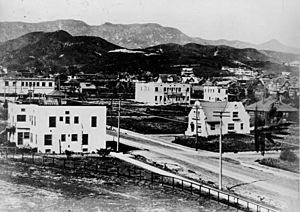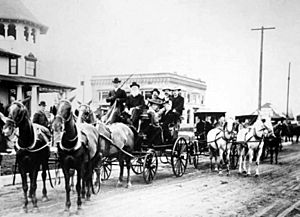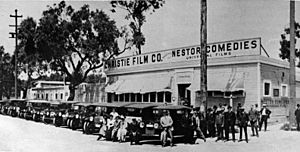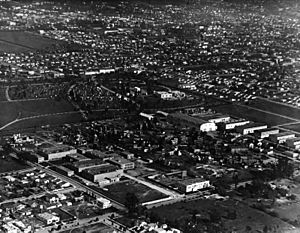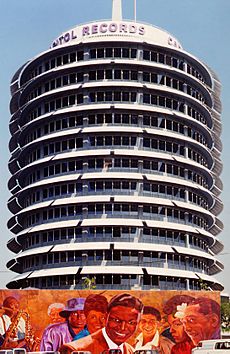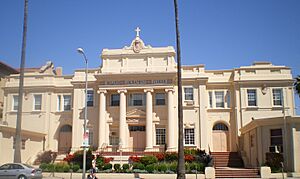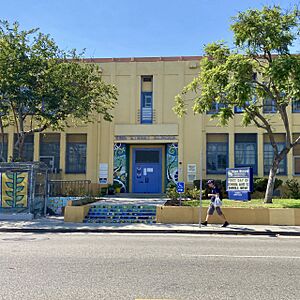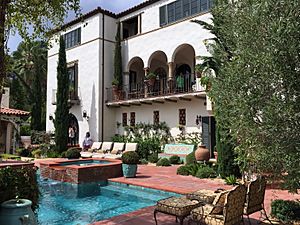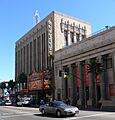Hollywood, Los Angeles facts for kids
Quick facts for kids
Hollywood
|
|
|---|---|
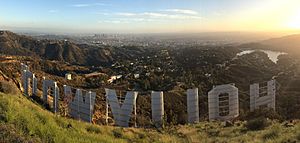
The Hollywood Sign in front of Hollywood Hills in January 2019
|
|
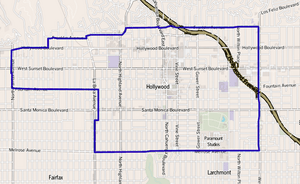
Map of the Hollywood neighborhood of Los Angeles
|
|
| Country | United States |
| State | California |
| County | Los Angeles |
| City | Los Angeles |
| Incorporated | 1903 |
| Merged with Los Angeles | 1910 |
| Named for | Hollywood, an estate in present day Brookfield, Illinois |
| Elevation | 354 ft (108 m) |
| Area code | 323 |
Hollywood, also known as Tinseltown, is a famous neighborhood in the city of Los Angeles, California. It's located in the central part of Los Angeles County, California. Hollywood's name is often used to mean the entire U.S. film industry and the people who work in it. Many big film studios, like Sony Pictures, Walt Disney Studios, Paramount Pictures, Warner Bros., and Universal Pictures, are found in or near Hollywood.
Hollywood became its own town in 1903. Later, in 1910, parts of Hollywood joined with the city of Los Angeles. Soon after, the movie industry started to move to this area.
Contents
Hollywood's Story
How Hollywood Began
A real estate developer named H. J. Whitley bought a large ranch. He planned to build a new town there. He shared his ideas with important people like General Harrison Gray Otis, who published the Los Angeles Times.
A woman named Daeida Wilcox Beveridge helped develop Hollywood. She heard the name Hollywood from a friend who had an estate in Illinois. Mrs. Wilcox liked the name because it sounded nice and she thought holly brought good luck. She suggested it to her husband, Harvey Henderson Wilcox, who had bought 120 acres of land in 1887. He officially named the property Hollywood in August 1887.
By 1900, Hollywood had a post office, a newspaper, a hotel, and two markets. Los Angeles was about 10 miles away. A streetcar line connected the two, but the trip took two hours. An old fruit-packing house was turned into a stable, which helped with transportation.
The Hollywood Hotel opened in 1902. H.J. Whitley built it to attract people to buy land. This hotel became very famous and was a central place for social life and movie stars for many years. Whitley also helped bring electricity and build roads, which helped Hollywood grow. His development, Whitley Heights, was named after him.
Becoming a City
Hollywood officially became a city on November 14, 1903. In 1904, people in Hollywood voted to ban the sale of alcohol, except for medical reasons. Hotels and restaurants were not allowed to serve wine or liquor.
In 1910, Hollywood voted to join Los Angeles. This was done to get a better water supply and access to Los Angeles's sewer system.
The Movie Industry Arrives
In the early 1900s, many movie companies started making films in Jacksonville, Florida. But they moved because of the weather and other issues. By 1912, major film companies began setting up in or near Los Angeles.
One big reason filmmakers moved was to avoid Thomas Edison's company in New Jersey, which held many movie patents. Filmmakers were often sued for using these patents. Moving to Los Angeles made it harder for Edison's company to stop their productions. Also, the weather in Los Angeles was perfect for filming year-round, and there were many different landscapes nearby, like mountains and plains. This made Hollywood a great place for film studios.
The first movie made in Hollywood was In Old California (1910), directed by D. W. Griffith. It was a 17-minute short film. Even though Hollywood banned movie theaters before it joined Los Angeles, Los Angeles itself had no such rule.
The first movie studio in Hollywood was the Nestor Film Company. It opened in October 1911 at 6121 Sunset Boulevard. By the 1920s, Hollywood's film industry was huge. By the 1930s, studios like Paramount, Warner Bros., RKO, and Columbia controlled everything from making films to showing them. Hollywood was producing about 600 films each year!
Hollywood became known as Tinseltown and the "dream factory" because of the exciting and glamorous movie industry.
Hollywood's Growth
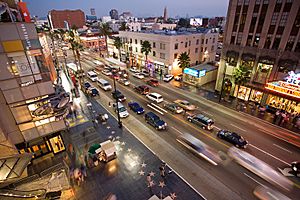
In 1923, a huge sign saying HOLLYWOODLAND was put up in the Hollywood Hills. It was an advertisement for a new housing development. In 1949, the Hollywood Chamber of Commerce agreed to remove the "LAND" part. So, the sign became HOLLYWOOD, referring to the district itself.
The Hollywood Freeway was built through Hollywood in the early 1950s. The Capitol Records Building was built in 1956. The Hollywood Walk of Fame was created in 1958 to honor artists and others who contributed to entertainment. It officially opened on February 8, 1960.
In 1999, the Los Angeles County Metro Rail Red Line subway opened in Hollywood. It has stops along Hollywood Boulevard. The Dolby Theatre, which opened in 2001, is where the Oscars are held every year. This theater is part of the Hollywood & Highland Center mall, which is where the historic Hollywood Hotel used to be.
Making Hollywood New Again
In the 1980s, Hollywood faced some tough times. Many famous buildings were at risk of being torn down. But since 2000, Hollywood has been improving a lot. Old buildings are being fixed up, and new apartments, hotels, and shops are being built. For example, Columbia Square, a historic studio complex, was once the home of CBS. Now, it's a modern office and retail complex with cable TV networks like MTV and Comedy Central.
Trying to Break Away
In 2002, some Hollywood residents wanted the area to become its own city, separate from Los Angeles. Voters had a chance to decide on this. However, the idea failed by a large number of votes in the citywide election.
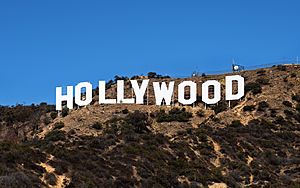
Hollywood's Location
Hollywood is surrounded by other areas. To the north are the Hollywood Hills. To the east are Los Feliz and East Hollywood. To the south are Larchmont and Hancock Park. To the west are Fairfax, West Hollywood, and Hollywood Hills West.
The main streets that mark Hollywood's borders are Hollywood Boulevard and Franklin Avenue to the north, Western Avenue to the east, Melrose Avenue to the south, and La Brea Avenue or the West Hollywood city line to the west.
In 1918, H.J. Whitley had Whitley Heights designed as a Mediterranean-style village in the hills. It became the first community where many celebrities lived. Other areas within Hollywood include Franklin Village, Little Armenia, Spaulding Square, Thai Town, and Yucca Corridor.
Trademarking Attempt
In 1994, the Hollywood Chamber of Commerce tried to trademark the name "Hollywood." This would have meant that other towns named Hollywood, like Hollywood, Alabama, would have to pay to use the name. However, these towns successfully fought against this attempt.
Hollywood's Weather
| Weather chart for Hollywood, California | |||||||||||||||||||||||||||||||||||||||||||||||
|---|---|---|---|---|---|---|---|---|---|---|---|---|---|---|---|---|---|---|---|---|---|---|---|---|---|---|---|---|---|---|---|---|---|---|---|---|---|---|---|---|---|---|---|---|---|---|---|
| J | F | M | A | M | J | J | A | S | O | N | D | ||||||||||||||||||||||||||||||||||||
|
3.5
68
47
|
3.8
70
49
|
3.2
70
51
|
0.9
74
53
|
0.3
75
57
|
0.1
80
61
|
0
85
64
|
0.1
86
65
|
0.4
84
64
|
0.4
80
59
|
1.2
73
51
|
2
69
47
|
||||||||||||||||||||||||||||||||||||
| temperatures in °F precipitation totals in inches |
|||||||||||||||||||||||||||||||||||||||||||||||
|
Metric conversion
|
|||||||||||||||||||||||||||||||||||||||||||||||
Hollywood has a hot-summer Mediterranean climate. This means winters are usually mild and rainy, but still have many warm, sunny days. Summers are hot, sunny, and dry, with almost no rain from April to October. While summer days can be hot, they are cooler than in the San Fernando Valley. Spring and fall are generally warm and pleasant.
Sometimes, strong, dry winds called Santa Ana winds blow, usually in fall and winter. These winds bring higher temperatures and lower humidity, which increases the risk of wildfires. Smog can sometimes happen in the summer. In May and June, Hollywood can be foggy and cloudy, a phenomenon known as "May Gray" or "June Gloom".
The hottest temperature ever recorded in Hollywood was 112 °F (44 °C) on June 26, 1990. The coldest was 24 °F (–4 °C) on December 8, 1978, and December 23, 1990.
| Climate data for Hollywood, Los Angeles, California | |||||||||||||
|---|---|---|---|---|---|---|---|---|---|---|---|---|---|
| Month | Jan | Feb | Mar | Apr | May | Jun | Jul | Aug | Sep | Oct | Nov | Dec | Year |
| Record high °F (°C) | 91 (33) |
91 (33) |
94 (34) |
106 (41) |
102 (39) |
112 (44) |
107 (42) |
105 (41) |
110 (43) |
108 (42) |
100 (38) |
92 (33) |
112 (44) |
| Mean daily maximum °F (°C) | 68 (20) |
70 (21) |
70 (21) |
74 (23) |
75 (24) |
80 (27) |
85 (29) |
86 (30) |
84 (29) |
80 (27) |
73 (23) |
69 (21) |
76 (24) |
| Mean daily minimum °F (°C) | 47 (8) |
49 (9) |
51 (11) |
53 (12) |
57 (14) |
61 (16) |
64 (18) |
65 (18) |
64 (18) |
59 (15) |
51 (11) |
47 (8) |
56 (13) |
| Record low °F (°C) | 28 (−2) |
34 (1) |
35 (2) |
37 (3) |
42 (6) |
49 (9) |
53 (12) |
51 (11) |
46 (8) |
40 (4) |
34 (1) |
24 (−4) |
24 (−4) |
| Average precipitation inches (mm) | 3.47 (88) |
3.81 (97) |
3.24 (82) |
0.85 (22) |
0.31 (7.9) |
0.07 (1.8) |
0.02 (0.51) |
0.14 (3.6) |
0.35 (8.9) |
0.39 (9.9) |
1.16 (29) |
1.98 (50) |
15.80 (401) |
| Source 1: Records: MyForecast, MSN | |||||||||||||
| Source 2: Averages: PlantMaps | |||||||||||||
People of Hollywood
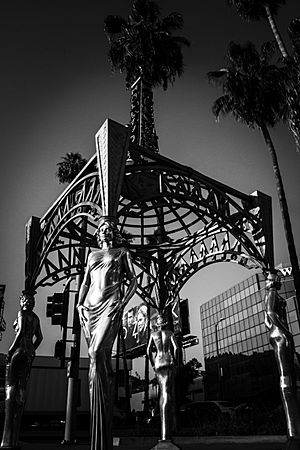
In 2000, about 77,818 people lived in Hollywood. The average age was 31. Hollywood is a very diverse place, with people from many different backgrounds. About 42% of residents were Latino or Hispanic, and 41% were Non-Hispanic White. Many residents were born outside the United States, with Mexico and Guatemala being common birthplaces.
The average household income in 2008 was $33,694. Most people in Hollywood (92.4%) rent their homes.
These were the ten neighborhoods or cities in Los Angeles County with the highest population densities, according to the 2000 census, with the population per square mile:
- Koreatown, Los Angeles, 42,611
- Westlake, Los Angeles, 38,214
- East Hollywood, Los Angeles, 31,095
- Pico-Union, Los Angeles, 25,352
- Maywood, California, 23,638
- Harvard Heights, Los Angeles, 23,473
- Hollywood, Los Angeles, 22,193
- Walnut Park, California, 22,028
- Palms, Los Angeles, 21,870
- Adams-Normandie, Los Angeles, 21,848
Homelessness in Hollywood
In 2022, there were 1,374 people experiencing homelessness in Hollywood.
Radio and Television in Hollywood
Hollywood has a long history with radio and television. KNX was the last radio station to broadcast from Hollywood, leaving in 2005.
On January 22, 1947, KTLA became the first commercial television station west of the Mississippi River to start broadcasting from Hollywood. Later that year, The Public Prosecutor became the first TV series filmed in Hollywood. Today, KTLA and KCET are the last TV stations with Hollywood addresses.
Learning in Hollywood
About 28% of Hollywood residents aged 25 and older have a four-year college degree.
Public Libraries
Hollywood has several public libraries: the Will and Ariel Durant Branch, John C. Fremont Branch, and the Frances Howard Goldwyn – Hollywood Regional Branch. They are all part of the Los Angeles Public Library system.
Schools in Hollywood
Public schools in Hollywood are run by the Los Angeles Unified School District (LAUSD).
Here are some of the schools in Hollywood:
- Temple Israel of Hollywood Day School (private)
- Gardner Street Elementary School (LAUSD)
- Selma Avenue Elementary School (LAUSD)
- Grant Elementary School
- Young Hollywood (private elementary)
- Hollywood High School (LAUSD)
- Hollywood Community Adult School (LAUSD)
- Blessed Sacrament School (private elementary)
- Helen Bernstein High School (LAUSD)
- Richard A. Alonzo Community Day School (LAUSD)
- Beverly Hills RC School (private elementary)
- Hollywood Schoolhouse (private elementary)
- Joseph LeConte Middle School (LAUSD)
- Hollywood Primary Center (LAUSD elementary)
- Santa Monica Boulevard Community Charter School
- Vine Street Elementary School (LAUSD)
- Hubert Howe Bancroft Middle School (LAUSD)
- Larchmont Charter School (elementary)
- Cheder Menachem (private elementary)
Colleges in Hollywood
Hollywood is also home to several colleges:
- AFI Conservatory
- Emerson College ELA-Hollywood Center
- Los Angeles City College
- Los Angeles Film School
- Los Angeles Recording School
Famous Places in Hollywood
- CBS Columbia Square
- Charlie Chaplin Studios
- Cinerama Dome
- Crossroads of the World
- Dolby Theatre
- Earl Carroll Theatre (now Nickelodeon on Sunset)
- El Capitan Theatre
- Frederick's of Hollywood
- Gower Gulch
- Grauman's Chinese Theatre
- Grauman's Egyptian Theatre
- Hollywood & Western Building
- Ovation Hollywood
- Hollywood and Vine
- Hollywood Forever Cemetery
- Hollywood Heights, Los Angeles
- Hollywood Heritage Museum
- Hollywood Palladium
- Hollywood Masonic Temple
- Hollywood Museum
- Hollywood Walk of Fame
- Hollywood Wax Museum
- Knickerbocker Hotel
- Madame Tussauds Hollywood
- Musso & Frank Grill
- Pantages Theatre
- Roosevelt Hotel
- Sunset Gower Studios
Yearly Events
The Academy Awards, also known as the Oscars, are held every year in late February or early March. Since 2002, they have mostly taken place at the Dolby Theatre in Hollywood.
The annual Hollywood Christmas Parade travels down Hollywood Boulevard. It is broadcast on TV in Los Angeles and across the United States. The 75th parade was held in 2006.
The Hollywood Half Marathon started in 2012 and happens every April. This event includes a Half Marathon, 10K, 5K, and Kids Fun Run. It helps raise money and awareness for local youth homeless shelters.
Images for kids
-
The Grauman's Chinese Theatre before 2007
-
The Jim Henson Studio and former Charlie Chaplin Studios
-
Tour bus on Hollywood Boulevard
-
Ripley's Believe It or Not! Odditorium
-
The Hotel Roosevelt
See also
 In Spanish: Hollywood para niños
In Spanish: Hollywood para niños



